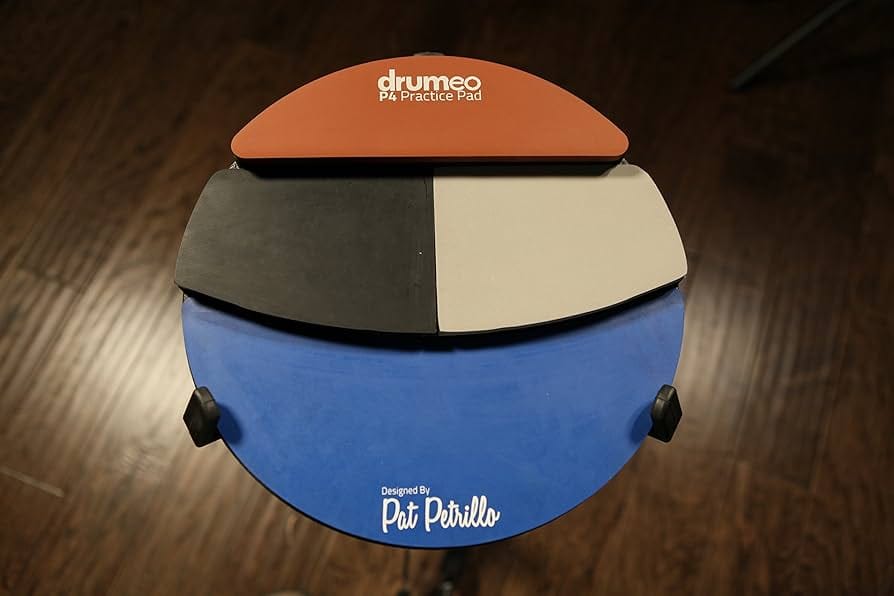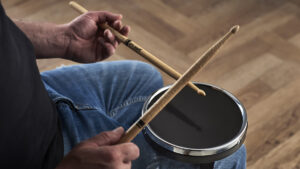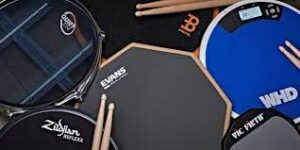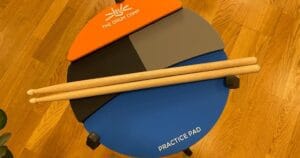Are you a novice drummer? If so, you can find a drum practice pad a useful instrument for honing your talents. As it is a tiny, portable and noiseless piece of equipment meant to assist drummers in developing their technique without the need for a complete drum set. But how can it be useful for a beginner? It is useful for learning rudiments, timing or just strengthening muscle memory.
So, here are some tips provided by 5 Core to help you get the most out of your practice sessions – drum practice pad.
Choose the Right Practice Pad
The first step in introducing a practice pad into your drumming regimen is to choose the right one. It is available in a variety of sizes and materials – so it’s crucial to choose one that meets your demands. Now, let’s check for the following features with us, 5 Core:
- Dimensions: Standard practice pads range from 6 to 12 inches in diameter. Novices typically begin with a compact 6-inch pad for ease of transport; although bigger pads can provide a more authentic experience.
- Surface: Rubber surfaces are typical for practice pads—offering a nice equilibrium of resistance. Certain pads offer a softer or firmer sensation; so try various options to discover the one that is most comfortable for you.
- Mounting Choices: Certain practice pads are made to rest directly on a surface – whereas others can be attached to a stand or snare drum. Determine if you require a stand or a pad suitable for any flat surface.
Practice on Fundamentals
Rudiments serve as the foundation of drumming and are the most effective method to enhance control and coordination! These fundamental patterns are essential for every kind of drumming and practicing them on a pad is a great method to enhance your technique. Here are some basic principles to begin with:
- Single Stroke Roll (RLRL)
- Double Stroke Roll (RRLL)
- Paradiddle (RLRR LRLL)
- Flams (a decorative note preceding the primary note)
Work on these patterns slowly and concentrate on keeping stick heights uniform; timing steady and a relaxed hold.
Concentrate on Grip and Stick Control
A practice pad is ideal for improving your stick control! A right grip is crucial to prevent tension and enhance your overall drumming skill. So, you’ll want to practice three main grips:
- Matched Grip: Both hands grasp the sticks identically, with palms oriented downward.
- Traditional Grip: One hand clutches the stick with the palm facing upwards, typically employed in jazz drumming.
- Focus on Motions: Focus on your grip and stick handling to guarantee smooth and effective motions.
Maintaining relaxed wrists and using correct rebound techniques can aid in enhancing both speed and precision.
Control Your Speed and Precision
A major advantage of practicing on a pad is the opportunity to concentrate on control free from the interruptions of a complete drum kit. Start by practicing at reduced speeds and concentrate on maintaining consistent dynamics and uniform strokes. With time, speed will develop; but the focus is on precision. Here’s the way to do it:
- Begin slowly and steadily raise the tempo as you become at ease with the rhythm.
- Use a metronome to maintain timing and monitor your development.
- Strive for consistency in loudness and tempo – particularly when executing rolls or sticking sequences.
Incorporate Dynamics
One of the advantages of rehearsing on the pad is the capability to concentrate on dynamics — how hard or soft you play. Varying your volume adds musicality and helps you control your strokes more precisely. Try rehearsing below given following:
- Accentuations: Play certain notes louder( e.g., accentuation to the first notes in a paradiddle).
- Ghost Notes: Play some notes veritably vocally to produce a further intricate meter( common in funk and jazz).
Use Different Sticking Ways.
Once you’re comfortable with the basics, you can practice different sticking ways. These ways will help you make your collaboration and make your playing further versatile. Try these practices:
- Single Strokes: Alternate between right and left-hand strokes (R-L-R-L).
- Double Strokes: Alternate between two strokes per hand (R-R-L-L).
- Flams: Play a quick and soft note followed by the main note (like a “grace note”).
Practice Constantly
Thickness is crucial when learning any musical instrument; and the practice pad is no exception! Set away time each day to work on your fashion. Indeed 10 – 15 twinkles of focused practice can yield significant progress over time. The more you exercise – the better your muscle memory will come – which will result in bettered performance on the pad tackle.
Incorporate Timekeeping Practices
Numerous drummers use a practice pad to work on their timing and meter. Playing on with a metronome is one of the stylish ways to develop a solid chronometer. You can also exercise tapping out different time autographs to broaden your metrical chops. Start with introductory time signatures like 4/4; also move on to more complex ones like 7/8 or 5/4 as you become more comfortable.
Stay Relaxed and Avoid the Pressure
One of the most common miscalculations beginners make while rehearsing is holding pressure on their hands, wrists or arms. Pressure will decelerate you down and potentially beget injury over time. Therefore, always aim for a relaxed grip and make sure your movements are fluid and natural.
However, take a break and stretch your hands and wrists – if you start to feel tense.
Set Claim and Track Progress
As with any skill, it’s important to set attainable goals and track your progress! Whether it’s learning a specific rudiment or achieving a certain speed – having pretensions will help keep you motivated. Record your practice sessions and hear back to notice areas where you can improve.







All Comments
Helpful thought-provoking ideas, and valuable takeaways that can truly make a difference.
I appreciated the formatting — easy to skim and still informative.